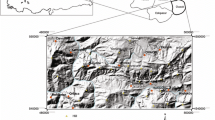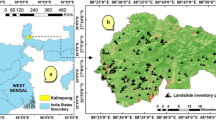Abstract
The Büyük Menderes watershed is the largest drainage watershed in Western Anatolia with an area of approximately 26,000 km2. In the study area, almost 863 landslides occurred, extending over 222 km2 with a mean landslide area of 0.21 km2. In this study, landslide susceptibility assessments were carried out using artificial neural network method, which is one of the data-driven methods. In this study, that will contribute to the mitigation or control of the landslides caused by the reasons controlling the spatial and temporal distribution of landslides created in the GIS and MATLAB environment by using scientific and technological approaches within the framework. Since derivative activation function is also used in back-propagation artificial neural networks, its derivative is easily calculated in order not to slow down the calculation. Levenberg–Marquardt back-propagation (LM), resilient back propagation back-propagation (trainrp), scaled conjugate gradient back-propagation (trainscg), conjugate gradient with Powell/Beale restarts back-propagation (traincgb), and Fletcher-Powell conjugate gradient back-propagation (traincgf) algorithms are used, which constantly interrogate the link between the input parameter and the result output, and at least one cell’s output is given as an input to any other cell. Geology, digital elevation model, slope, topographic wetness index, roughness index, plan, profile curvatures, and proximity to active faults and rivers were used as landslide conditioning factors. In susceptibility assessments, landslides were separated by 70% analysis, 15% test, and 15% validation datasets by random selection method. The performances of the landslide susceptibility maps were assessed by the area under the ROC curve (AUC), accuracy (ACC), precision, recall, F1 score, Kappa test error histogram, and confusion matrix, respectively. The area under the receiver operating characteristic curves, analysis, testing, validation, landslides, and study areas were found between 0.873 and 0.911. The susceptibility map had a high prediction rate in which high and very high susceptible zones corresponded to 26% of the study area including 82% of the recorded landslides.













Similar content being viewed by others
Data availability
The datasets used and/or analyzed during the current study are available from the corresponding author on reasonable request.
References
Abanco C, Hürlimann M, Moya J, Berenguer M (2016) Critical rainfall conditions for the initiation of torrential flows. Results from the Rebaixader catchment (Central Pyrenees). J Hydrol 541:218–229. https://doi.org/10.1016/j.jhydrol.2016.01.019
Achour Y, Garcia S, Cavaleiro V (2018) GIS-based spatial prediction of debris flows using logistic regression and frequency ratio models for Zezere River basin and its surrounding area, Northwest Covilha, Portugal. Arab J Geosci 11:1–17
Akgun A, Kincal C, Pradhan B (2012) Application of remote sensing data and GIS for landslide risk assessment as an environmental threat to Izmir city (west Turkey). Environ Monit Assess 184:5453–5470
Amato G, Palombi L, Raimondi V (2021) Data–driven classification of landslide types at a national scale by using artificial neural networks. Int J Appl Earth Obs Geoinf 104:102549. https://doi.org/10.1016/j.jag.2021.102549
Basheer I, Hajmeer MN (2001) Artificial neural networks: Fundamentals, Computing, Design, and Application. J Microbiol Meth 43:3–31. https://doi.org/10.1016/S0167-7012(00)00201-3
Bui DT, Tsangaratos P, Nguyen VT, Liem NV, Trinh PT (2020) Comparing the prediction performance of a deep learning neural network model with conventional machine learning models in landslide susceptibility assessment. CATENA 188:104426. https://doi.org/10.1016/j.catena.2019.104426
Çan T, Tekin S (2019) Landslide susceptibility assessment around Babadağ (Denizli) Town using logistic regression method. Kahramanmaraş Sütçü İmam Üniv Mühendislik Bilimleri Dergisi Özel Sayı 22:48–56. https://doi.org/10.17780/Ksujes.594657
Cevik SY, Ulusay R (2005) Engineering geological assessments of the repeated plane shear slope instability threatening Babadag (Turkey) and its environmental impacts. Environ Geol 47:685–701. https://doi.org/10.1007/s00254-004-1197-7
Chapi K, Singh VP, Shirzadi A, Shahabi H, Bui DT, Pham BT, Khosravi K (2017) A novel hybrid artificial intelligence approach for flood susceptibility assessment. Environ Model Softw 95:229–245. https://doi.org/10.1016/j.envsoft.2017.06.012
Chawla A, Chawla S, Pasupuleti S, Rao ACS, Sarkar K, Dwivedi R (2018) Landslide susceptibility mapping in Darjeeling Himalayas, India. Adv Civ Eng 2018:6416492. https://doi.org/10.1155/2018/6416492
Chen W, Han HX, Huang B, Huang QL, Fu XD (2018a) A data-driven approach for landslide susceptibility mapping: a case study of Shennongjia Forestry District, China. Geomat Nat Haz Risk 9:735–751. https://doi.org/10.1080/19475705.2018.1472144
Chen W, Peng J, Hong H, Shahabi H, Pradhan B, Liu J, Zhu AX, Pei X, Duan Z (2018b) Landslide susceptibility modelling using GIS-based machine learning techniques for Chongren County, Jiangxi Province, China. Sci Total Environ 626:1121–1135. https://doi.org/10.1016/j.scitotenv.2018.01.124
Chu HJ, Chen YC (2018) Crowdsourcing photograph locations for debris flow hot spot mapping. Nat Hazards 90(3):1259–1276. https://doi.org/10.1007/s11069-017-3098-6
Cordoba JP, Mergili M, Aristizabal E (2020) Probabilistic landslide susceptibility analysis in tropical mountainous terrain using the physically based R slope stability model. Nat Hazard Earth Sys 20:815–829. https://doi.org/10.5194/nhess-20-815-2020
Corominas J, van Westen C, Frattini P, Cascini L, Malet JP, Fotopoulou S et al (2014) Recommendations for the quantitative analysis of landslide risk. Bull Eng Geol Env 73(2):209–263. https://doi.org/10.1007/s10064-013-0538-8
Das P, Bharat TV (2020) Reconstruction of a wetting-induced shallow landslide in Shillong, India. Proc Instit Civil Eng-Forensic Eng 173(2):48–53. https://doi.org/10.1680/jfoen.20.00003
Das G, Lepcha K (2019) Application of logistic regression (LR) and frequency ratio (FR) models for landslide susceptibility mapping in Relli Khola river basin of Darjeeling Himalaya, Indi. Sn Appl Sci 1(11):1453. https://doi.org/10.1007/s42452-019-1499-8
Duman TY, Olgun Ş, Çan T, Nefeslioğlu HA, Hamzaçebi S, Durmaz S, ve Çörekçioğlu Ş (2009) Türkiye Heyelan Envanteri Haritası-1/500000 ölçekli Denizli Paftası. MTA Özel Yayınlar Serisi- 21:22 (s. Ankara (In Turkish))
Duman TY, Olgun Ş, Çan T, Nefeslioğlu HA, Hamzaçebi S, Durmaz S, ve Çörekçioğlu Ş (2009) Türkiye Heyelan Envanteri Haritası-1/500000 ölçekli İzmir Paftası. MTA Özel Yayınlar Serisi 20:18 (s. Ankara (In Turkish))
Emre Ö, Duman TY, Özalp S, Şaroğlu F, Olgun Ş, Elmacı H, Çan T (2018) Active fault database of Turkey. Bull Earthq Eng 16:3229–3275. https://doi.org/10.1007/s10518-016-0041-2
FAO (2017) https://www.fao.org/news/archive/news-by-date/2017/en/. Accessed 30 Nov 2021
Fleiss JL (1981) Statistical Methods for Rates and Proportions, 1st edn. John Wiley & Sons, London, p 218
Gökçe O, Özden Ş, Demir A (2008) Türkiye’de Afetlerin Mekansal ve İstatistiksel Dağılımı. Afet Bilgileri Envanteri, Afet İşleri Genel Müdürlüğü, Ankara 118 (In Turkish)
Hu X, Lu Z, Pierson TC, Kramer R, George DL (2018) Combining InSAR and GPS to determine transient movement and thickness of a seasonally active low-gradient translational landslide. Geophys Res Lett 45:1453–1462. https://doi.org/10.1002/2017GL076623
Jenness J (2006) Topographic Position Index (tpi_jen.avx) extension for ArcView 3.x, v. 1.3a. Jenness Enterprises. http://www.jennessent.com/arcview/tpi.htm
Karsoliya S (2012) Approximating number of hidden layer neurons in multiple hidden layer BPNN architecture. Int J Eng Trends Technol 3(6):714–717
Kohonen T (1982) Self-organised formation of topologically correct feature maps. Biol Cybern 43:59–69
Konak N, ve Şenel M (2002) 1/500000 Ölçekli Türkiye Jeoloji Haritası Denizli Paftası. Maden Tetkik ve Arama Genel Müdürlüğü. Ankara (In Turkish)
Konak N (2002) 1/500000 Ölçekli Türkiye Jeoloji Haritası İzmir Paftası. Maden Tetkik ve Arama Genel Müdürlüğü. Ankara (In Turkish).
Kumsar H, Aydan Ö, Tano H, Çelik SB (2016) An integrated geomechanical investigation, multiparameter monitoring and analyses of Babadağ-Gündoğdu creep-like landslide. Rock Mech Rock Eng 49:2277–2299. https://doi.org/10.1007/s00603-015-0826-7
Min DH, Yoon HK (2021) Suggestion for a new deterministic model coupled with machine learning techniques for landslide susceptibility mapping. Sci Rep 11:6594. https://doi.org/10.1038/s41598-021-86137-x
Naghibi SA, Moghaddam DD, Kalantar B, Pradhan B, Kisi O (2017) A comparative assessment of GIS-based data mining models and a novel ensemble model in groundwater well potential mapping. J Hydrol 548:471–483. https://doi.org/10.1016/j.jhydrol.2017.03.020
Nsengiyumva JB, Luo G, Nahayo L, Huang X, Cai P (2018) Landslide Susceptibility Assessment Using Spatial Multi-Criteria Evaluation Model in Rwanda. Int J Environ Res Public Health 15:243. https://doi.org/10.3390/ijerph15020243
Panchal S, Shrivastava AK (2020) Application of analytic hierarchy process in landslide susceptibility mapping at regional scale in GIS environment. J Stat Manag Syst 23:199–206. https://doi.org/10.1080/09720510.2020.1724620
Pham BT, Prakash I, Singh SK, Shirzadi A, Shahabi H, Tran TTG, Buig DT (2019) Landslide susceptibility modeling using Reduced Error Pruning Trees and different ensemble techniques: Hybrid machine learning approaches. CATENA 175:203–218. https://doi.org/10.1016/j.catena.2018.12.018
Prasad P, Loveson VJ, Das S, Chandra P (2021) Artificial intelligence approaches for spatial prediction of landslides in mountainous regions of western India. Environ Earth Sci 80(21):720. https://doi.org/10.1007/s12665-021-10033-w
Rahmati O, Moghaddam DD, Moosavi V, Kalantari Z, Samadi M, Lee S, Bui DT (2016) An automated Python language-based tool for creating absence samples in groundwater potential mapping. Remote Sens 11(11):1375. https://doi.org/10.3390/rs11111375
Seyitoğlu G, Scott B (1991) Late Cenozoic crustal extension and basin formation in west Turkey. Geol Magaz 128:155–166
Seyitoğlu G, Scott B (1992) The age of the Büyük Mnederes graben (West Turkey) and its tectonic implications. Geol Mag 129:239–242
Sharma S, Mahajan AK (2019) A comparative assessment of information value, frequency ratio and analytical hierarchy process models for landslide susceptibility mapping of a Himalayan watershed, India. Bull Eng Geol Environ 78:2431–2448. https://doi.org/10.1007/s10064-018-1259-9
Silva RF, Marques R, Gaspar JL (2018) Implications of landslide typology and predisposing factor combinations for probabilistic landslide susceptibility models: a case study in Lajedo Parish (Flores Island, Azores-Portugal). Geosciences 8:153. https://doi.org/10.3390/geosciences8050153
Tekin S (2021) Completeness of landslide inventory and landslide susceptibility mapping using logistic regression method in Ceyhan Watershed (southern Turkey). Arab J Geosci 14:1706. https://doi.org/10.1007/s12517-021-07583-5
WorldClim, (2019). Global climate data. http://www.worldclim.org/ Accessed: 31.08.2020.
Xie W, Li XS, Jian WB, Yang Y, Liu HW, Robledo LF, Nie W (2021) A novel hybrid method for landslide susceptibility mapping-based GeoDetector and machine learning cluster: a case of Xiaojin County, China. ISPRS Int J Geo-Inf 10(2):93. https://doi.org/10.3390/ijgi10020093
Author information
Authors and Affiliations
Contributions
ST: (corresponding author) collected the datasets and analyzed the data, validation, writing the manuscript review and editing. TÇ: designed the research, methodology, investigation and editing.
Corresponding author
Ethics declarations
Ethics approval and consent to participate
Not applicable.
Consent for publication
Not applicable.
Competing interests
The authors declare no competing interests.
Additional information
Responsible Editor: Philippe Garrigues
Publisher's note
Springer Nature remains neutral with regard to jurisdictional claims in published maps and institutional affiliations.
Rights and permissions
About this article
Cite this article
Tekin, S., Çan, T. Slide type landslide susceptibility assessment of the Büyük Menderes watershed using artificial neural network method. Environ Sci Pollut Res 29, 47174–47188 (2022). https://doi.org/10.1007/s11356-022-19248-1
Received:
Accepted:
Published:
Issue Date:
DOI: https://doi.org/10.1007/s11356-022-19248-1




